- Details
Mercury Report
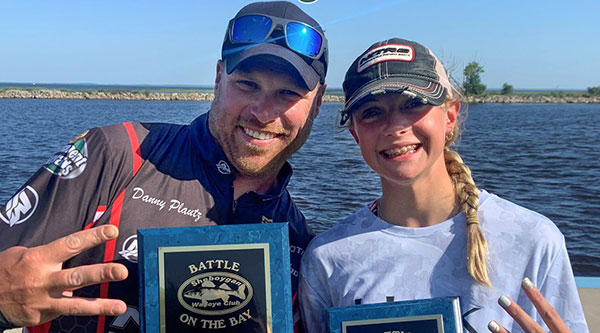 Danny Plautz and daughter Maggie
Danny Plautz and daughter Maggie
Like a lot of young ladies, 12-year-old Maggie Plautz has a lot on her plate.
For much of the year the rising eighth-grader from Lake Mills, Wisconsin, has dance classes up to six days a week, and, in season, also has a full slate of basketball practices and games. Not to mention keeping up with her schoolwork, an area in which she also excels. And like many kids from the Upper Midwest, she enjoys deer hunting and loves to go fishing with her father whenever she can.
But that’s where the similarities end between Maggie and the average tween. Sure, it’s fun when she goes fishing with her father, professional walleye angler and Mercury Pro Team member Danny Plautz, but they’re playing on a whole different level than the average father-daughter outing. Danny and Maggie have been fishing area walleye tournaments for about two years now, and the pairing is certainly not just a novelty. In fact, they’ve more than held their own in one of the most competitive walleye fishing regions in the country. However, it’s just another extracurricular activity for the youngster, with the added bonus of getting to spend time with her father.
“It’s really just for fun,” she said. “I don’t think of it as anything but fishing with my dad. I love doing it, and it’s just an activity. And I like the experience of standing next to him in front of an audience on the stage.
- Details
By Louie Stout
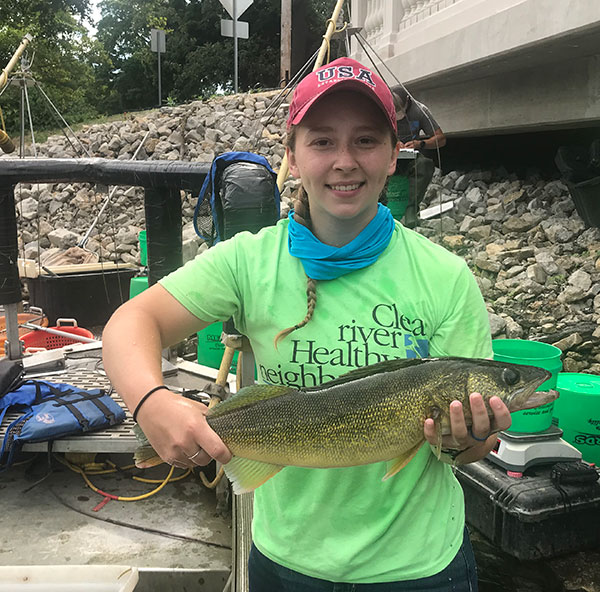 St. Joe River Walleye
St. Joe River Walleye
The bluegill and walleye population in Indiana waters of the St. Joseph River are doing quite well, according to Dar Deegan, aquatic biologist for Elkhart and South Bend.
The biologist spends many hours on the river each year surveying water quality and the health of fish populations.
He is somewhat concerned, however, about the diminishing sucker population which was once the dominate species that has now been replaced by sunfish populations.
While that may be good news to gamefish anglers, he is concerned that falling numbers of suckers signals a change in the food web. Suckers serve as an indicator to water quality issues.
“Suckers are a sensitive group of fish that feed on the equally sensitive critters on the bottom of the river,” Deegan explained. “This could be caused by the introduction of gizzard shad, zebra mussels as well as big flood events or even drought periods.”
Oddly enough, he noted that sunfish populations – to include bluegill, crappie, rock bass and long-ear sunfish – have exploded since shad showed up in the system. Shad compete for food with young gamefish.
“The river has cleared up with the zebra mussels’ influx which has led to different levels of sunlight penetration and more plant growth, so those things may play a role in sunfish expansion,” Deegan added. “Agriculture also is doing a better job with conservation land practices and it’s reducing some of the run-off problems coming into the river.”
- Details
Seaguar Report
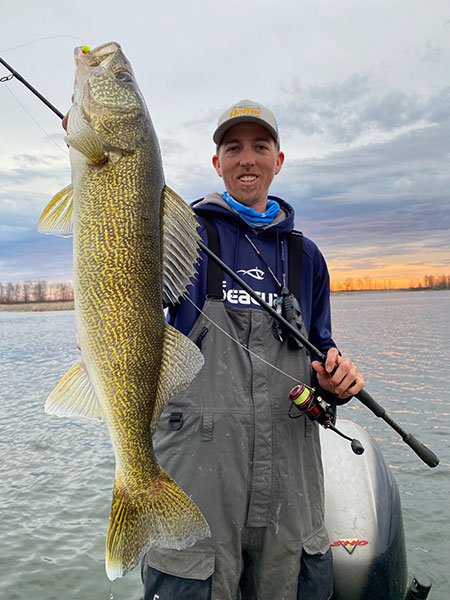 Josh Teigen with nice walleye
Josh Teigen with nice walleye
Fishing aquatic vegetation is second nature to bass anglers, but the green stuff is just as crucial for walleye fishing. They use weedlines as travel routes and know that grass holds plenty of forage, making them the perfect place to search for their next meal.
A trio of Wisconsin guides, Josh Teigen, Troy Peterson, and Jeff Evans, search out weeds in the late spring and early summer months. They have different approaches to fishing them, but they all work and help them and their clients catch some of their biggest walleyes of the year.
Slip Bobbers on Weedlines
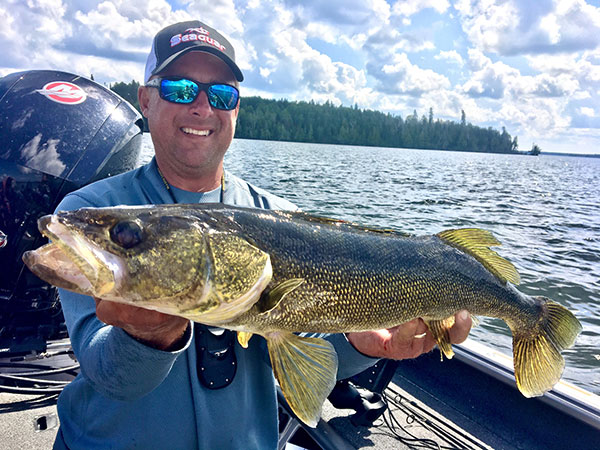 Iron River, Wisconsin's, Jeff Evans
Iron River, Wisconsin's, Jeff Evans
Iron River, Wisconsin's, Jeff Evans guides clients on various lakes for walleye from the May opener through the entire fishing season. Many tactics work when targeting grass on inland lakes for Evans, but he says a slip bobber rig with a minnow or leech is hard to beat.
"After the walleye spawn, they recover in deep water and then head to the weeds," says Evans. "As the new weed beds emerge, the walleye will follow the green, new growth and you can find these areas on your side imaging. They'll follow the edge as new grass grows and later in the year it might be in 15 to 20-feet of water on clear lakes, but only 8 to 12-feet of water on more stained lakes."
According to Evans, the bite typically lasts until the 4th of July, when many walleye switch gears to mud basins, reefs and points. "Some years, the bite can go all summer long and into the fall months," he says. "My theory is that it has to do with water temperatures. If it gets into the 70s too early, they'll get out deeper quicker, but they stick around if it's a gradual rise."
Evans likes to rig up his clients with a 7-foot medium-light spinning rod and a quality reel spooled with 30-pound Seaguar Smackdown Flash Green braid with a leader of 1- pound Gold Label fluorocarbon. On the business end, it's generally a slip bobber set to the desired depth with a slip knot and a ¼-ounce egg sinker. He then rigs a barrel swivel with an 18-inch leader of Gold Label with either a #1 Octopus hook or 1/16-ounce jighead used to rig the leech or minnow.
- Details
MDNR Report
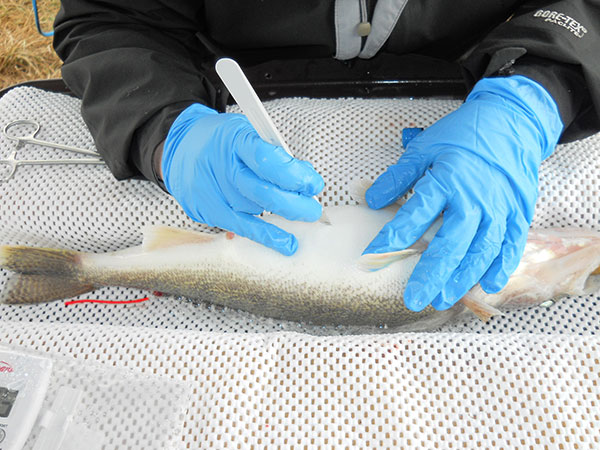 Transmitter being implanted in walleye
Transmitter being implanted in walleye
A new study begins this month on Saginaw Bay, using acoustic transmitters that will be implanted in walleye to help researchers with the Michigan DNR, Michigan State University and several partner agencies obtain data about where the fish spawn.
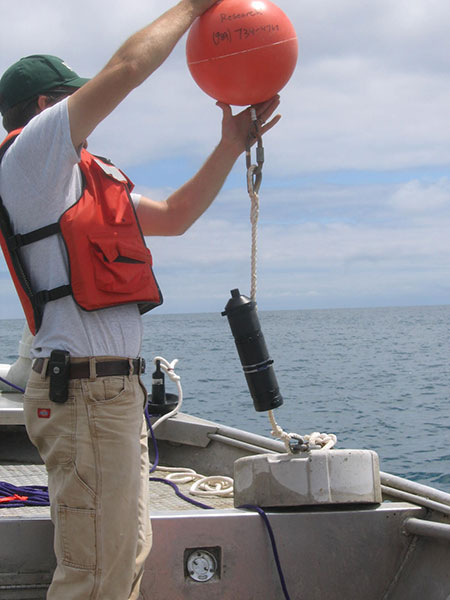 Acoustical receiver for tracking walleyeFish in such telemetry projects have acoustic transmitters affixed to them. Each transmitter then beeps a fish-specific code every few minutes. Acoustic receivers deployed in Lake Huron decode the tag beeps and log when fish tags are detected. The network of acoustic receivers in Saginaw Bay includes receivers in the mouths of rivers to listen for tagged fish moving to spawning grounds and receivers in Saginaw Bay to determine where walleye may be spawning.
Acoustical receiver for tracking walleyeFish in such telemetry projects have acoustic transmitters affixed to them. Each transmitter then beeps a fish-specific code every few minutes. Acoustic receivers deployed in Lake Huron decode the tag beeps and log when fish tags are detected. The network of acoustic receivers in Saginaw Bay includes receivers in the mouths of rivers to listen for tagged fish moving to spawning grounds and receivers in Saginaw Bay to determine where walleye may be spawning.
Having a better understanding of relative sources of natural reproduction for walleye will help fishery managers determine which rivers and reefs to protect and, when needed, where to invest in actions that enhance and improve fish habitat.





